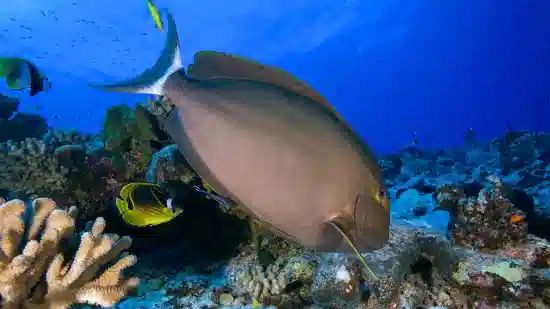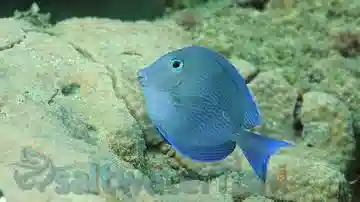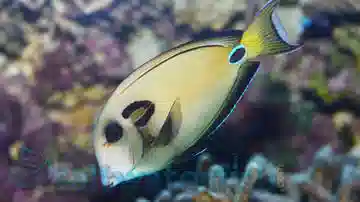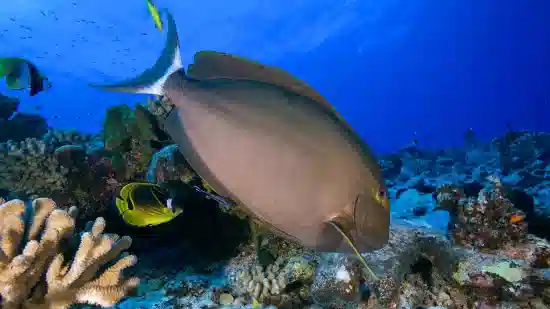Ring Tail Tang
Acanthurus auranticavus
(0 Reviews)

Ring Tail Tang
Acanthurus auranticavus
(0 Reviews)
{{ item.name }}
Size: {{ item.extra_field_3 }}
${{ getFormattedPrice(item.saleprice) }} ${{ getFormattedPrice(item.price) }}
To join the waiting list, click here
Free Shipping
With
$199.00
or more in Marine Life.
More details...
Ring Tail Tang Care Facts
| Care Level: | Easy |
|---|---|
| Temperament: | Peaceful |
| Diet: | Omnivore |
| Reef Safe: | Yes |
| Minimum Tank Size: | 180 gallons |
| Max Size: | 14 inches |
How To Let a Ring Tail Tang (Acanthurus auranticavus) Thrive In Your Aquarium
If you're a dedicated saltwater aquarium enthusiast seeking a unique addition to your underwater world, the Ring Tail Tang might just be the fish you're looking for. This comprehensive care guide covers everything you need to know about this species, from its natural habitat to its dietary needs, tank requirements, compatibility, and why you should consider acquiring it from Saltwaterfish.com.
Habitat of the Ring Tail Tang
The Ring Tail Tang, scientifically known as Acanthurus auranticavus, originates from the warm waters of the Indo-Pacific. Its habitat typically includes coral reefs, lagoons, and rocky substrates, where it can graze on algae and forage for its favorite foods.
Reef Compatibility of the Ring Tail Tang
This species is generally considered reef-safe. However, ensuring that your corals and other sessile invertebrates are securely anchored is crucial. Like many tangs, the Ring Tail Tang may occasionally graze on algal growth, posing a potential threat to more delicate reef organisms.
Size and Lifespan of the Ring Tail Tang
Ring Tail Tangs can grow to a maximum size of approximately 7-8 inches (18-20 cm). They can have a 5-10-year lifespan with proper care, depending on their environment and overall well-being.
Diet in Captivity of the Ring Tail Tang
In the wild, Ring Tail Tangs are herbivores, primarily feeding on various types of algae, residue, and small invertebrates. In captivity, providing them with a well-rounded diet replicating their natural food sources is crucial. High-quality marine algae sheets, dried seaweed, and marine pellets should comprise the bulk of their diet. Occasional treats of frozen foods like brine shrimp or mysis shrimp can also be offered to ensure a balanced nutritional intake.
Aquaculture and Availability of the Ring Tail Tang
Ring Tail Tangs are not typically available through aquaculture. However, Saltwaterfish.com is committed to providing hobbyists with responsibly sourced fish, ensuring that each Ring Tail Tang is healthy, acclimated, and ready to thrive in your aquarium.
Compatibility with Other Fish and Invertebrates of the Ring Tail Tang
Ring Tail Tangs generally have a peaceful temperament, making them compatible with many tank mates. However, they can become territorial with their kind and may exhibit aggression if kept in close quarters. It's advisable to house them in a sufficiently large tank and be mindful of their behavior when introducing new tank mates.
Sexual Dimorphism of the Ring Tail Tang
Ring Tail Tangs do not display sexual dimorphism, meaning that males and females share similar physical characteristics and coloration.
Juvenile to Adult Coloration Changes of the Ring Tail Tang
Juvenile Ring Tail Tangs are typically characterized by a vibrant yellow body with a striking ring pattern near the base of their caudal fin. As they mature into adulthood, their coloration may become less vivid, with the yellow hue giving way to a more subdued olive or brownish coloration.
Temperament of the Ring Tail Tang
The Ring Tail Tang is known for its peaceful demeanor, making it a suitable addition to a community aquarium. However, like many tang species, they may exhibit territorial behavior, so it's essential to provide adequate space and hiding spots to minimize potential conflicts.
Tank Requirements of the Ring Tail Tang
To ensure the well-being of your Ring Tail Tang's well-being, maintaining a tank with a minimum size of 180 gallons (approximately 284 liters) is essential. Water conditions should closely resemble their natural habitat, with a pH level between 8.1 and 8.4, a salinity level of 1.020-1.025, a stable temperature between 74-78°F (23-26°C), and moderate water flow to simulate ocean currents.
Common Names of the Ring Tail Tang
The Ring Tail Tang may also be known by other common names, such as the Ringtail Surgeonfish.
Compatible Tank Mates of the Ring Tail Tang
Here are five specific species that can make suitable tank mates for your Ring Tail Tang:
- Flame Angelfish (Centropyge loricula)
- Coral Beauty Angelfish (Centropyge bispinosa)
- Emperor Angelfish
- Royal Gramma (Gramma loreto)
- Lawnmower Blenny (Salarias fasciatus)
Why Choose the Ring Tail Tang from Saltwaterfish.com
Acquiring a Ring Tail Tang from Saltwaterfish.com ensures you're introducing a captivating and adaptable addition to your saltwater marine aquarium. With their commitment to responsibly sourced fish and a wealth of resources to support your aquarium journey, Saltwaterfish.com makes it convenient and reliable to enjoy the distinctive beauty of Ring Tail Tangs in your home aquarium.
With its unique coloration and peaceful nature, the Ring Tail Tang is a valuable addition for novice and experienced aquarists looking to diversify their saltwater marine aquarium. Aquarists can admire the elegance of the Ring Tail Tang in their aquatic domain by providing them with specific care requirements and a suitable environment.
Currently Ring Tail Tang does not have any reviews.








